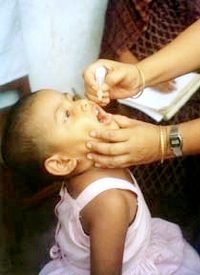
Despite millions of dollars in funding for polio eradication, the Pakistani regime and its health department have failed to erase the scourge — owing to corruption.
On January 24, Pakistani President Asif Ali Zardari once again kicked off an anti-polio campaign, declaring that it would be “criminal negligence” not to wipe it out from the country. He acknowledged that polio is a crippling disease that continues to threaten children, adding that Pakistan is among only a few countries in the world that are still not completely polio-free.
What the President did not mention is that past and present criminal negligence is likely the main reason polio still has a foothold in Pakistan.
Enough money has been spent on anti-polio campaigns to have long since taken care of the problem — yet there are still no results. Along with international funding, the Bill and Melinda Gates Foundation recently announced another donation of $17 million to Pakistan specifically for polio eradication, bringing the foundation’s total gifts for this purpose to more than $100 million so far.
When the polio-eradication campaign was first launched in 1993 by Pakistani authorities, official statistics listed more than 30,000 cases of the disease throughout the country. The World Health Organization (WHO) and its partners launched the polio eradication campaign in 1994 for about 80 countries. Although many countries achieved the target in just three to four years, Pakistan, India, Afghanistan, and Nigeria are still far behind the target even after 17 years of consistent campaigns. Among the remaining four, Pakistan has the most polio cases, with 139 reported in 2010.
The Global Polio Eradication Initiative in Pakistan claims there are three main reasons why polio still persists, despite the mass campaigns and world initiatives:
In some areas of the mega city of Karachi (Sindh), insufficient political ownership has resulted in significant operational gaps in SIA quality”; “In some areas of North West Frontier Province (NWFP) and Federally Administered Tribal Areas (FATA), access to children by vaccination teams is dangerously hampered by insecurity”; “In the Quetta area (Balochistan), polio persists due to a combination of both reasons.
But these factors did not stop polio eradication in other nations.
Prime Minister Sayed Yousaf Raza Gillani declared that “failure is not an option any more” and asked federal and provincial health ministries to “work tirelessly to remove the remaining bottlenecks, which threaten to reverse gains achieved over the years.” Gillani also announced that he will head a national task force to oversee the progress on polio eradication, which will include the chief Ministers and Governor of the Khyber-Pakhtunkhwa.
Although the recent steps are reflective of the Prime Minister’s seemingly genuine efforts to deal with the matter, many predict that corruption will undo any good-faith efforts.
A source in the Ministry of Health revealed that the Extended Polio Immunization (EPI) teams have already missed about 30 percent of the expected coverage area, particularly the Federally Administered Tribal Areas (FATA), some other interior parts of the Khyber Pakhtunkhawa (KPK), and the far-flung towns in the Sindh Province — the parts of the country most vulnerable to polio. Seventy cases of the disease were reported last year in FATA, 26 in Sindh, and 25 in KPK.
On an average, 80,000 field workers are involved in each polio vaccination round, during which teams move from house to house to administer polio drops to children. The health experts estimate that an average child born between 1994 and 2003 has received the oral polio drops 30 times. Though the medical experts involved in the campaign say an overdose of polio vaccine makes no difference, doctors advise that it be given only twice or three times.
There have been rumors that Pakistan is using low-quality vaccines. But Dr. Altaf Bosan, national manager of the Extended Polio Immunization (EPI) project, maintained that the vaccine used in Pakistan is the same material responsible for polio eradication in over 70 countries in the past decade and a half, adding, “There may be some other technical reasons or human inefficiency on the part of immunization teams and the higher management, but [the problem is] not the vaccine quality.”
Officials from the World Health Organization (WHO) and the United Nations Children’s Education Fund (UNICEF) suggest that in spite of about 70 rounds of anti-polio vaccination campaigns, the people directly involved have not improved the campaign methodology, which brings to the forefront the question of the credibility of those responsible for properly disbursing international donations.
A WHO official who asked for anonymity said that at present about 50 international polio experts are involved in the campaign in Pakistan, some having worked in the effort since 1994. He explained to The New American:
It is the matter of their huge salaries and hefty per diems; if polio is eradicated in Pakistan, where would the reemployed retired bureaucrats and the international experts go who are so-called experts only in polio eradication?
There is also huge corruption in awareness-raising and advocacy campaigns. The designated money is not all spent but [is either] embezzled in connivance of vendors by short supplies of communication material or it is supplied on uncompetitive and exaggerated rates.
Azhar Ali Qureshi, the executive director of Eco-Conservation Initiatives, believes that neither the international experts nor officials in Pakistan want an end to the campaign, because it involves huge amounts of money, most of which goes to their own pockets. There are many “ghost” teams, he adds, and these non-existent groups’ remuneration and cost of logistics is eaten up by the senior campaign officers.
Though there is no outside corroboration of his claims, the failed polio campaigns seem to speak for themselves.



